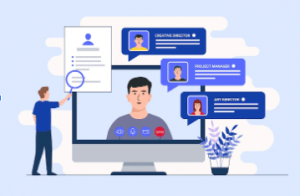Before the pandemic, offices were bustling with activity. But then COVID-19 struck, forcing everyone to work from home. Over three years later, remote work has become the norm. This shift has significantly changed the hiring landscape.

In recent years, virtual hiring has emerged as a pivotal trend, reshaping how companies scout, evaluate, and onboard talent. As remote work gains traction, organizations have recognized the benefits of virtual hiring, including cost savings, access to a broader talent pool, and increased efficiency.
However, conducting virtual hiring effectively requires thoughtful planning, the right tools, and strategies to ensure that the process is as seamless and productive as traditional hiring.
What is Virtual Hiring?
Virtual hiring refers to the process of recruiting, interviewing, and onboarding candidates remotely using digital tools and online platforms. This process eliminates the need for in-person meetings, making it easier for companies to reach candidates in different locations. It typically includes the following stages:
Job Posting and Candidate Sourcing: Posting job openings on online job boards and social media platforms.
Virtual Interviews: Conducting interviews using video conferencing tools like Zoom, Microsoft Teams, or Google Meet.
Digital Assessments: Using online tests or projects to assess candidates’ skills.
Virtual Onboarding: Welcoming and training new hires through digital onboarding platforms, video calls, and virtual team introductions.
Advantages Of Virtual Hiring
There are a lot of things that have become better because of online recruitment. From offering a better pool of candidates to saving time, money and resources, virtual recruitment is changing the recruitment process.
No Geographical Barriers
Saves Time & Resources
Shorter Time To Hire
Competitive Advantage
Better Candidate Experience
Fairer Recruitment Process
 In a competitive job market, partnering with the right recruitment agency can make all the difference. Whether you’re looking for tech hiring agencies in Bangalore or non-tech hiring agencies in Hyderabad, the right partner will streamline your recruitment process and help you secure the best talent.
In a competitive job market, partnering with the right recruitment agency can make all the difference. Whether you’re looking for tech hiring agencies in Bangalore or non-tech hiring agencies in Hyderabad, the right partner will streamline your recruitment process and help you secure the best talent.
How to Conduct Virtual Hiring Effectively
While virtual hiring offers several advantages, it also presents unique challenges. Without face-to-face interactions, evaluating a candidate’s cultural fit and soft skills can be difficult. To ensure a smooth and effective hiring process, organizations must adopt best practices designed specifically for virtual recruitment.
1. Leverage the Right Technology
To conduct virtual hiring effectively, you need reliable technology that ensures smooth communication and interaction. Invest in high-quality video conferencing tools that allow for clear video and audio transmission, as well as screen sharing capabilities for presentations or demonstrations.
Popular tools include, Zoom, Microsoft Teams, Google Meet etc. Beyond video conferencing, applicant tracking systems (ATS) can streamline the recruitment process, helping HR teams manage candidate data, schedule interviews, and track progress.
2. Prepare Structured Interviews
Virtual interviews should be structured just as carefully as in-person ones. Prepare a list of standard questions to ensure fairness and consistency in evaluating candidates. Structured interviews also help reduce bias, as each candidate is evaluated using the same criteria.
Ask Behavioral Questions: Focus on questions that ask candidates to describe how they’ve handled specific situations in the past. This helps reveal critical soft skills like problem-solving, adaptability, and communication.
Assess Technical Skills: If the role requires technical expertise, consider using online assessments or ask candidates to complete real-time problem-solving exercises.
3. Test for Technical Proficiency
Given that the virtual hiring process takes place entirely online, it’s essential to assess candidates’ comfort with technology. For roles that involve regular use of digital tools, consider giving candidates a small task that requires them to navigate software or troubleshoot issues.

Additionally, check whether candidates are familiar with tools relevant to your company’s operations, such as collaboration platforms (Slack, Trello) or industry-specific software.
4. Evaluate Cultural Fit
Cultural fit remains a crucial part of the hiring process, even in a virtual environment. To gauge whether a candidate aligns with your company’s values and culture, consider organizing panel interviews where different team members can interact with the candidate.
Video Calls: Encourage casual video chats with potential team members, so they can get a feel for the company’s work style.
Interactive Sessions: Organize collaborative problem-solving tasks or discussions during the interview process to observe how well the candidate interacts with others in a remote setting.
5. Communicate Expectations Clearly
Clear communication is key to avoiding misunderstandings during virtual hiring. Ensure that candidates are well informed about each step of the process, from initial screenings to final interviews.
Set Clear Timelines: Provide candidates with a timeline of the entire hiring process, so they know what to expect and when.
Clarify the Role: Since candidates won’t be able to experience the office environment, it’s important to offer detailed descriptions of the role, team dynamics, and company expectations.
6. Enhance Virtual Onboarding
Once you’ve made a hire, the onboarding process is your chance to ensure a smooth transition. In a virtual setting, it’s important to make new hires feel connected and supported, despite the lack of physical presence.
Create a Digital Welcome Kit: Include necessary documents, company handbooks, and an introduction to the company’s digital tools.
Organize Virtual Meet-and-Greets: Schedule video calls for the new hire to meet key team members and understand the broader organization.
Offer Ongoing Support: Make sure new hires know where to go for technical support or onboarding questions.
Virtual hiring is not just a temporary solution—it’s a long-term strategy that can help organizations attract top talent and streamline the recruitment process. By leveraging the right tools, preparing structured interviews, assessing both technical and cultural fit, and maintaining clear communication, companies can successfully navigate the challenges of virtual hiring. As remote work continues to grow, mastering virtual hiring will be key to building strong, adaptable teams for the future.







